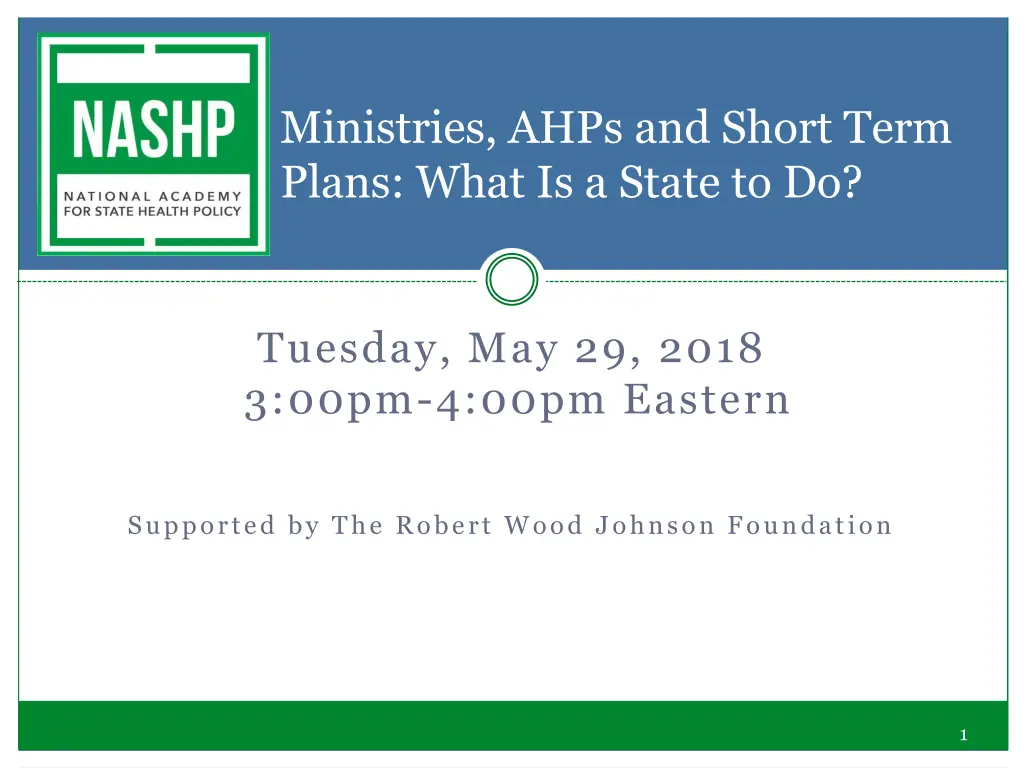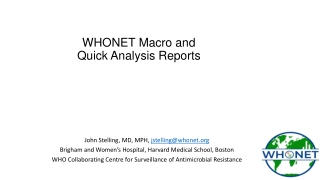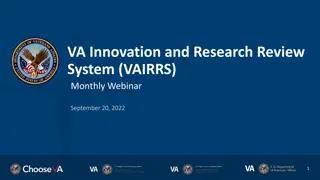
Healthcare Policy Forum: State Strategies for Ensuring Insurance Market Stability
Join experts from Georgetown University's Center on Health Insurance Reforms as they discuss the impact of alternative coverage options on individual market stability. Learn about potential risks and strategies for state intervention to address these challenges. This forum, supported by The Robert Wood Johnson Foundation, provides valuable insights for policymakers and stakeholders in the healthcare industry.
Download Presentation

Please find below an Image/Link to download the presentation.
The content on the website is provided AS IS for your information and personal use only. It may not be sold, licensed, or shared on other websites without obtaining consent from the author. If you encounter any issues during the download, it is possible that the publisher has removed the file from their server.
You are allowed to download the files provided on this website for personal or commercial use, subject to the condition that they are used lawfully. All files are the property of their respective owners.
The content on the website is provided AS IS for your information and personal use only. It may not be sold, licensed, or shared on other websites without obtaining consent from the author.
E N D
Presentation Transcript
Ministries, AHPs and Short Term Plans: What Is a State to Do? Tuesday, May 29, 2018 3:00pm-4:00pm Eastern Supported by The Robert Wood Johnson Foundation 1
Todays Experts Kevin Lucia, Senior Research Professor, Center on Health Insurance Reforms, Georgetown University Kevin Lucia, J.D., M.H.P., is a Research Professor and Project Director at Georgetown University's Health Policy Institute. As part of a specialized research team, Mr. Lucia conducts extensive legal analysis on how states and the federal government regulate private health insurance with a focus on access, affordability and adequacy of coverage. Mr. Lucia's research includes analysis of state and federal laws, pending legislation, and current market practices related to private health insurance. Dania Palanker,Assistant Research Professor, Center on Health Insurance Reforms, Georgetown University Dania Palanker, J.D., M.P.P. is an Assistant Research Professor at the Center on Health Insurance Reforms (CHIR) at Georgetown s Health Policy Institute. She analyzes state and federal health insurance market reforms, including implementation of the Affordable Care Act (ACA), with an emphasis on insurance benefit design, access to health care, and coverage for chronic health conditions. JoAnn Volk,Senior Research Professor, Center on Health Insurance Reforms, Georgetown University JoAnn Volk, M.A. is a Research Professor at the Georgetown University Center on Health Insurance Reforms. There she directs research, authors papers, and provides technical assistance on state and federal regulation and legislation governing private health insurance, including health insurance marketplaces under the Affordable Care Act. 2
Ministries, AHPs and Short Term Plans: What Is a State to Do? Kevin Lucia, J.D., M.H.P. Dania Palanker, J.D., M.P.P. JoAnn Volk, M.A. Georgetown University Center on Health Insurance Reforms 3 May 29, 2018
About Georgetowns Center on Health Insurance Reforms (CHIR) A team of experts on private health insurance and health reform Conduct research and policy analysis, provide technical assistance to federal and state policymakers, regulators, and consumer advocates Based at Georgetown University s McCourt School of Public Policy Learn more at https://chir.georgetown.edu/. 4
Alternative Coverage Options Threatening the Stability of the Individual Market Effort to expand the availability of and access to alternatives to ACA-compliant insurance Presidential Executive Order issued October, 2017 Risk of healthy enrollees could be siphoned out of the individual market Leading to smaller, sicker risk pool with consumers facing higher premiums and fewer plan options Problem could be compounded when individual mandate is eliminated in 2019 5
Alternative Coverage Options Threatening the Stability of the Individual Market Alternative Coverage Options Poised to Expand in 2019 Short Term Plans Final regulation in development Association Health Plans Final regulation at OMB Health Sharing Ministries Current exemption from individual mandate Others 6
Short-Term Limited Duration Insurance: Background Designed to fill temporary gaps in coverage Pre-ACA provided HIPAA creditable coverage Not considered individual health insurance under federal law. Separate risk pool from ACA-compliant market. Exempt from ACA standards. Unless state provides otherwise. 7
Short Term Plans: Exclusions Almost always exclude pre-existing conditions Often exclude some Essential Health Benefits* 100% exclude maternity 71% exclude prescription drugs 62% exclude substance use treatment 43% exclude mental health *Source: Kaiser Family Foundation Other exclusions in plans currently for sale: Treatment of joints, spine, bones, connective tissue unless an injury Hospital emergency due to illness (unless confined) Kidney or end stage renal disease 8
Short-Term Plans: Limits and Cost-Sharing Benefits generally capped $250,000 - $2 million Some per contract period, others per lifetime Some issuers use internal limits such as: $2,500 in surgeon & anesthesiologist fees per surgery $1,000 per night in hospital $250 for ambulance $150,000 for transplant services Different Cost-Sharing Conventions Deductible may not count towards out of pocket maximum Family deductible may be 3x the individual deductible 9
Short Term Plans: Underwriting Post-claims underwriting can lead to rescission even if initially pass underwriting 10 Source: eHealthinsurance.org
Short-term Plans: Federal Regulation Rule change in 2016, because of concerns: Consumers were using short-term as primary coverage (not as a gap-filler) Short-term enrollment causing adverse selection against compliant market Current rule: Coverage duration must be less than 3 months, including extensions Enrollment in STLDI does NOT satisfy individual mandate Proposed rule change in 2018 Extend duration allowance to less than 12 months Allow extensions (with issuer s consent) beyond this term [And, no mandate penalty in 2019.] 11
Short-term Plans: Current State Regulation Some states limit contract duration: 6 or 12 months most common limits OR and VT limit to 3 months Some states exempt plans under 6 months from some regulations, but allow longer plans Ten states require coverage of all state benefit mandates Such as diabetes care management or TMJ treatment No states require coverage of all Essential Health Benefits Three states effectively ban short-term plans MA, NJ, NY 12
State Options to Address Short-Term Plans (1) Limit contract duration to 3 or 6 months Prevent stacking of multiple plans Prohibit renewals & define renewals as issuance of new policy within specified timeframe Limit coverage by one insurer to specified timeframe in 365 day period Limit coverage of individual in short-term plans to specified timeframe in 365 day period Prohibit waiving health status underwriting to people already enrolled 13
State Options to Address Short-Term Plans (2) Level playing field by requiring compliance with (some/all) individual market rules All state benefit mandates Essential health benefits No rescissions Preexisting condition protections Appeals process Reduce risk of market segmentation Assess short-term issuers for reinsurance funds Set minimum medical loss ratio (MLR) Limit rating factors Prohibit sale to people eligible for marketplace coverage 14
State Options to Address Short-Term Plans (3) Improve transparency and oversight Track enrollment Conduct regulatory review Require additional consumer disclosures Other state efforts underway: Ban short-term plans Use regulatory authority to define, limit duration, improve consumer protections 15
Questions on Short Term Plans Dania Palanker, J.D., M.P.P. Assistant Research Professor Georgetown University Center on Health Insurance Reforms Dania.palanker@georgetown.edu 202-687-0964 16
Association Health Plans: Background and Current Framework AHP health plan sponsored by an employer-based association, such as a professional or trade group AHPs exist under the ACA but are not a distinct category of health insurance coverage. AHP coverage sold to: Individuals is regulated as individual market coverage; Small groups is regulated as small group market coverage Exception: when a group of employers can be considered bound together as a bona fide single employer group may be treated as a large- employer health plan 17
Association Health Plans: Proposed Rule Would make it easier for employers to join together to form associations that would be treated as large-group coverage AHP could form solely for purpose of offering insurance Commonality of interest could be demonstrated where members are: In the same trade/industry, etc., or Have their principal place of business in the same geographic region (including multistate metro areas) Would allow membership by the self-employed 18
Association Health Plans: Proposed Rule Would prevent AHPs from conditioning membership on health status, or using health status in determining benefit eligibility and premiums As a large-group plan, an AHP would NOT be subject to ACA rules regarding premium rating and benefits Raises possibility of preemption of state regulatory authority 19
Association Health Plans: The Intent of Rule Change Responding to executive order directing agencies to consider regulations expanding access to AHPs Make it easier for small employers and the self- employed to achieve advantages of scale sometimes enjoyed by large employers Reducing admin costs Facilitating self-insurance Greater market power Gives consumers more options at lower premiums 20
Association Health Plans: The Risks AHPs have a long history of financial instability, insolvencies, and fraud States generally have a better track record than the feds in limiting these problems Tradeoffs that come with increased plan flexibility Proposal allows AHPs to vary rates by age (without limitation), gender, occupation, and group size Benefit packages can be designed to discourage enrollment by those likely to use care Plans playing by different rules segmentation and adverse selection Siphons off healthy risks, leaving compliant market smaller, sicker, and more expensive This was pre-ACA experience (e.g., Kentucky) 21
State Options to Address AHPs Level the playing field Require compliance with (some/all) individual/small group market rules Restrict AHPs CA does not allow new MEWAs, so only a handful remain Limit membership to small businesses Employers with at least 1 employee Reduce risk of market segmentation Assess AHPs; invest funds in reinsurance Assert jurisdiction over out-of-state AHPs 22
Questions on Association Health Plans Kevin Lucia, J.D., M.H.P. Research Professor Georgetown University Center on Health Insurance Reforms kwl@georgetown.edu 202-687-4928 23
Health Care Sharing Ministries: Background Historically, an alternative for certain religious communities that object to traditional insurance, instead share members health care cost burdens How they work: Membership limited to those who share religious beliefs (although not in all cases) Members make defined monthly contribution ( share ) May vary based on level of coverage, age, health indicators Members submit claims for sharing and if eligible, can have costs offset by other members shares; claims typically deemed ineligible include those that are: Considered in conflict with religious test for members Related to a pre-existing condition 24
Health Care Sharing Ministries: Regulation ACA recognized their role for certain religious communities by granting exemption from the individual mandate ACA exemption applies to defined ministries at 26 USC 5000A(d)(2)(B) Does not impede state authority to regulate HCSMs 30 states have safe harbor for HCSMs, specifically exempting them from insurance regulation Typical features: requirement to provide monthly statement of member payment requests and contributions and written notice that HCSM is not insurance nor a guarantee of payment. Some required annual audit be publicly available 25
Health Care Sharing Ministries: Membership and Features Enrollment in HCSMs has reportedly grown substantially, from fewer than 200,000 before ACA to more than a million No independent data on membership Audits required under ACA and some state safe harbors provide only financial information ACA mandate exemption may have been original driver, but affordability appears to be primary driver now Many using features that closely resemble insurance: Advertising during open enrollment Paid brokers Provide network Pre-existing condition exclusions 26
Health Care Sharing Ministries: Potential Risks Consumer confusion: marketing and plan designs may mislead consumers into thinking they re getting insurance Some features may cross line into something more akin to operating as an insurer Depending on actual membership and future growth, could contribute to selection against regulated market Most enroll individuals and families, but at least one markets to small employers 27
State Options to Address HCSMs Establish reporting requirement to collect data to understand growth and potential impact on market Issue consumer alert educating consumers on limits of HCSMs In states with safe harbor, monitor for compliance with definition of exempt HCSMs Some features, in particular, might fall outside definition, such as use of brokers, facilitating payments between members, failure to apply religious test for membership Take action against those that operate illegally as insurers 28
Questions on Health Care Sharing Ministries JoAnn Volk, M.A. Research Professor Georgetown University Center on Health Insurance Reforms joann.volk@georgetown.edu 202-687-3944 29
Thank You! Kevin Lucia kwl@georgetown.edu 202-687-4928 Dania Palanker dania.palanker@georgetown.edu 202-687-0964 JoAnn Volk joann.volk@georgetown.edu 202-687-3944 30
Questions & Discussion Please type your questions into the chat box. 31
Thank you! Your opinion is important to us. After the webinar ends, you will be redirected to a web page containing a short survey. Your answers to the survey will help us as we plan future NASHP webinars. 32






















